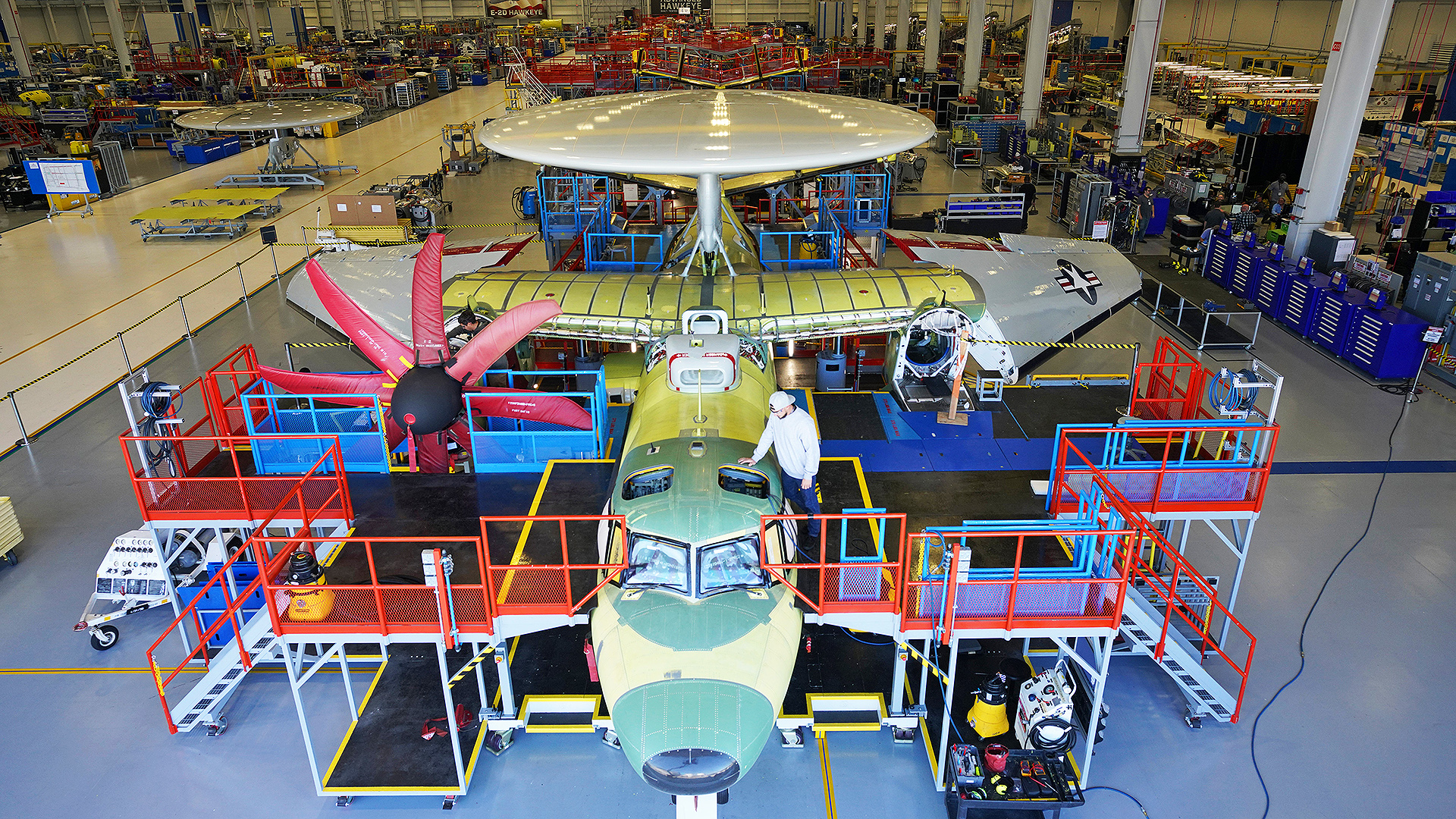On a sweltering August afternoon, as the E-2D-equipped Reagan Carrier Strike Group plowed the waters not far from Taiwan while the Chinese military threatened aggressive action toward the breakaway republic, workers at Northrop Grumman’s St. Augustine Manufacturing Center, or SAMC, were busy adding mid-air refueling capabilities and several other modifications to two similar E-2D Advanced Hawkeye airborne early warning aircraft.
They are the latest of several current and planned updates designed to elevate the potency of the latest version of the iconic twin-engined turboprop with a saucer-like radar dome and four-finned tail that first took flight 15 years ago. The original design that would become the E-2A first flew nearly 62 years ago. These enhancements also come as the audiences around the globe saw the Hawkeye in action Hollywood style via its cameo appearance in the hugely successful Top Gun: Maverick.
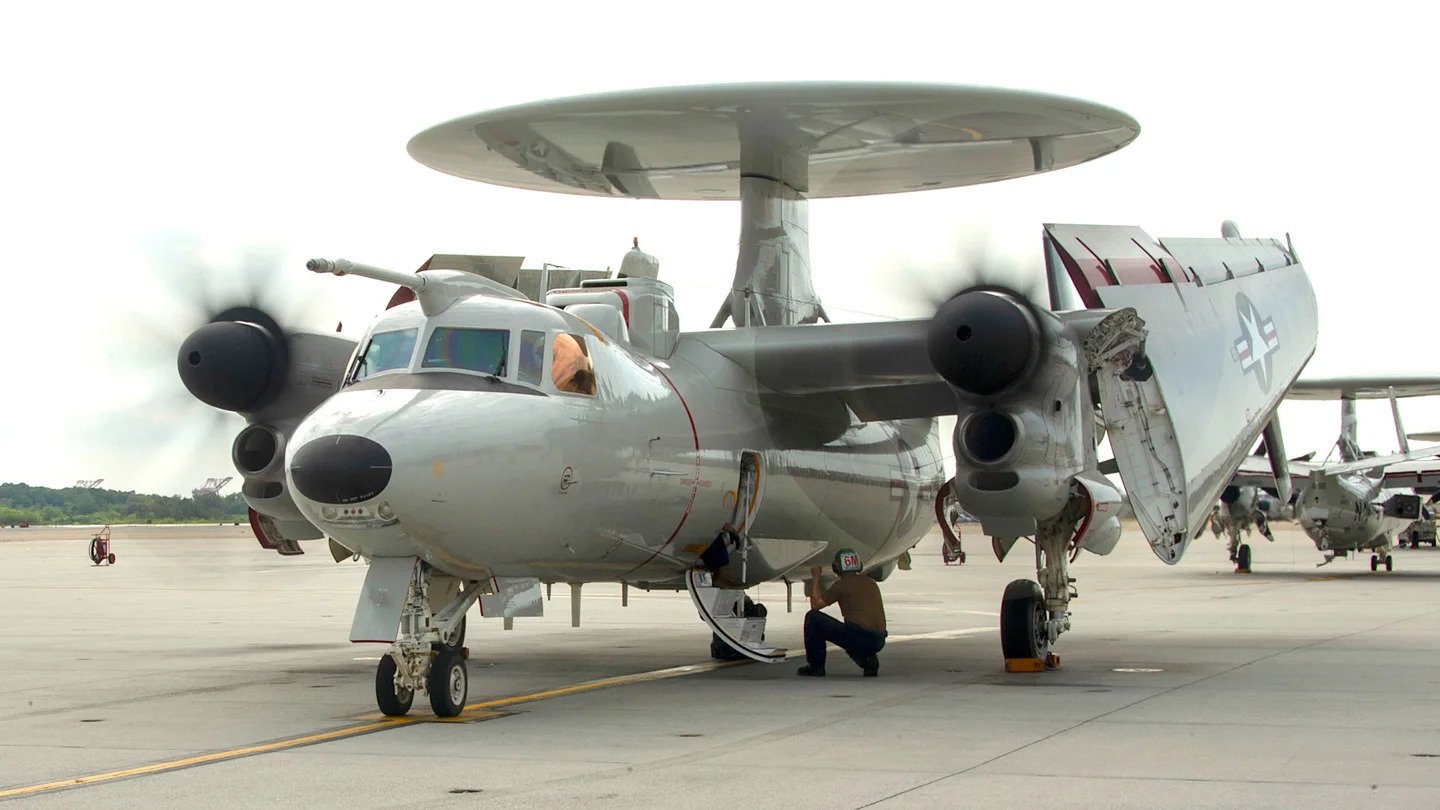
For the Navy, constant updating of the E-2D – currently patrolling the skies over Europe and in the Pacific and set to fly into the 2040s – is critical given what the ungainly-looking aircraft brings to the table. It is the carrier strike group’s eyes in the sky, surveilling huge areas of air and sea, directing fighter aircraft on their missions, and working as an airborne networking node that is capable of exchanging vast amounts of data between aircraft, warships, and more. It is the definition of a high-value, low-density, force-multiplying asset and it has never been more important than it is today.
Read all about what it is like to be a radar operator on the E-2 Hawkeye in this past War Zone feature.
“The Air Boss [Navy Vice Adm. Kenneth Whitesell, Commander, Naval Air Forces/Commander, Naval Air Force, U.S. Pacific Fleet] has stated that the E-2D is the BMC2 [battle management command and control] node within the air wing of the future,” Janice Zilch, Northop Grumman Vice President, multi-domain command and control programs, told a small group of reporters this week during a facility tour.
And for good reason.
As noted, not only do they provide vital airborne early warning and battle management functions for Carrier Strike Groups, but the Advanced Hawkeyes have also become a central node in the Navy’s cooperative engagement capability (CEC) efforts, which include the sea service’s overarching Naval Integrated Fire Control-Counter-Air (NIFC-CA) networking concept. In this role, E-2Ds can already significantly extend the reach and flexibility of both the carrier air wing and the surface combatants in the carrier strike group. The data fusion and relay functions the aircraft provides also allow those other assets to engage targets beyond the range of their own sensors, something you can read about in more detail here.
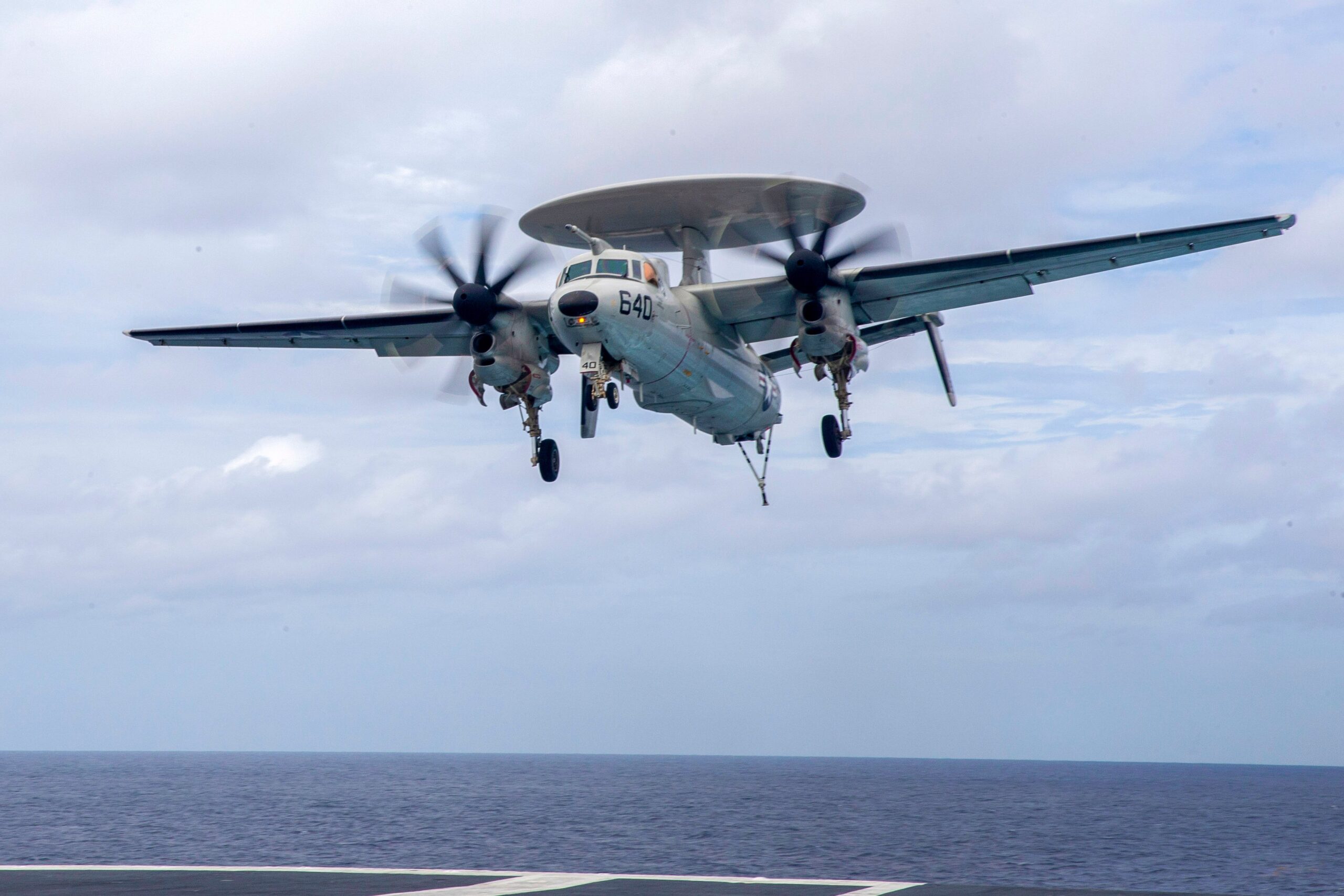
There was a reluctance during The War Zone’s visit to Northrop Grumman’s St. Augustine plant on Tuesday to say much about those systems, other than the E-2D is “the most critical node” in the system, which “would not exist without the E-2D.”
But Northrop Grumman was happy to talk about the total package of airborne warning and battle management capabilities that the Advanced Hawkeye delivers.
“You’ve also probably heard the E-2D referred to as the digital quarterback of the fleet,” Zilch said Tuesday. “Well, I’m going to elevate that today. And I’m going to say we’re more than digital offensive-defensive coordinator of the fleet.”
With a crew of five, and an impressive assortment of sensors including the hugely-capable Lockheed Martin’s AN/APY-9 radar, the E-2D ensures that “from a battle management command and control perspective, we’re moving those kill web timelines as much as possible to the left.”
“So I think it’s more than just the quarterback perspective,” Zilch added. The carrier strike group relies “on our capability every day. Without an E-2 in the air, the strike packages don’t go into harm’s way. We drive that strike group lethality and that power projection for naval aviation.”
The Hawkeye’s Nest
On any given day, there are Advanced Hawkeyes patrolling around the world, scanning for threats from enemy fighters to hard-to-spot targets flying over in dense littoral and overland environments, like cruise missiles and drones.
“Everyone’s tracking stuff in Ukraine,” Navy CMDR Guillermo Carrillo, fielding deputy program manager for the E-2/C-2 airborne command and control systems program office, told reporters. “We have an E-2D flying right now in the Mediterranean Sea. I can’t talk too much about what they’re doing. It’s classified. But what’s important is they are serving a critical mission right now in real-world events.”
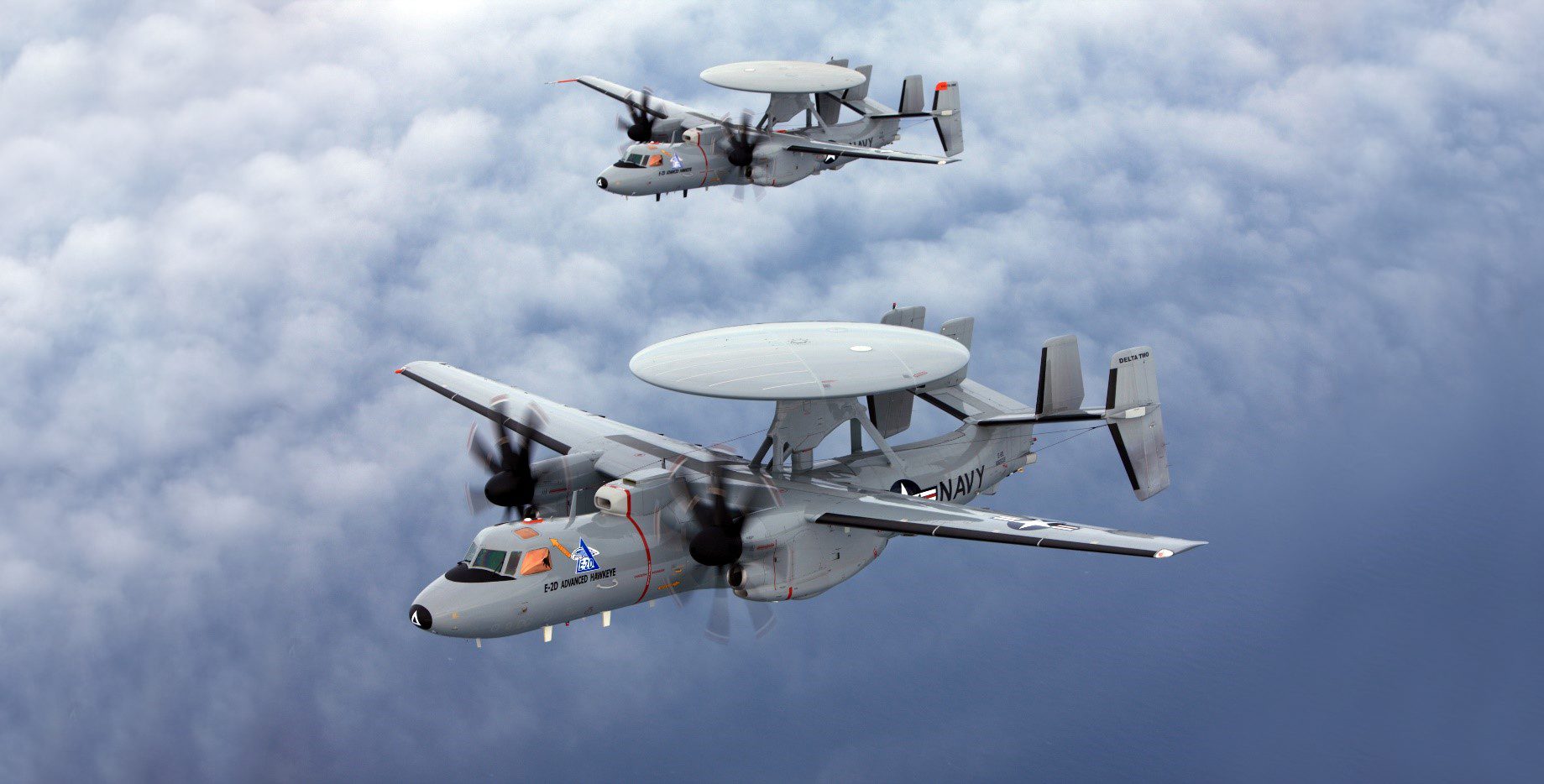
“And then on the other side of the world, in the Pacific Theater, E-2Ds are a critical part of the innovative kill chain. And you see, we’re getting great reports from the West Coast squadrons for real-world stuff they’re doing with a sensor that other E-2s and other platforms were unable to do. So what the E-2D is doing matters.”
As Carrillo speaks, hundreds of workers across this sprawling 151-acre facility with 31 buildings and 1.1 million square feet of office and manufacturing space are both putting together new Advanced Hawkeyes and updating old ones. It is one of the few plants where the entire construction process takes place in one location. To do so, 1,100 employees work in shifts around the clock every day of the week to turn 30,000 parts into one of the world’s most advanced airborne sensor platforms.
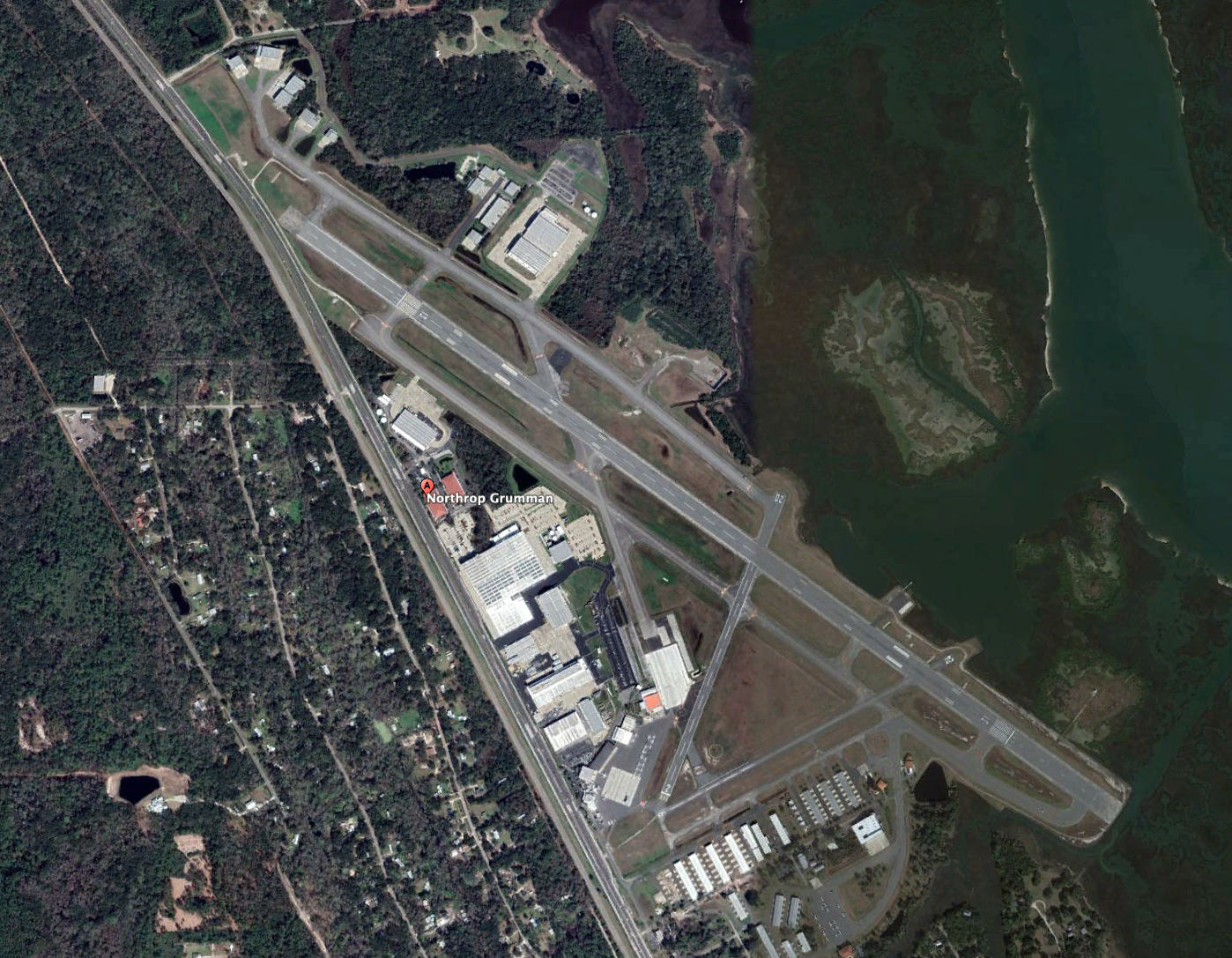
To date, Northrop Grumman has delivered 55 Advanced Hawkeyes to the Navy with at least another 23 on order under the program of record. The Navy is also seeking funding for eight more on top of that for a total of 86. In addition, the company is also building 13 E-2Ds for Japan – of which four have already been delivered with another two coming by the end of this year. There will also be three E-2Ds built for France, as well the modification of the older E-2Cs operated by Taiwan and Egypt.
The aircraft going to Japan and France won’t be exactly the same, however. Because Japan won’t be launching them from aircraft carriers, it has asked Northrop Grumman to build a so-called wet wing system, with fuel cells in the wings. And the French variants won’t have updates that allow it to integrate with CEC and NIFC-CA.
As for the upgrades to the Taiwanese and Egyptian E-2Cs, Northop Grumman said it is up to those countries to provide details about how they are being upgraded.
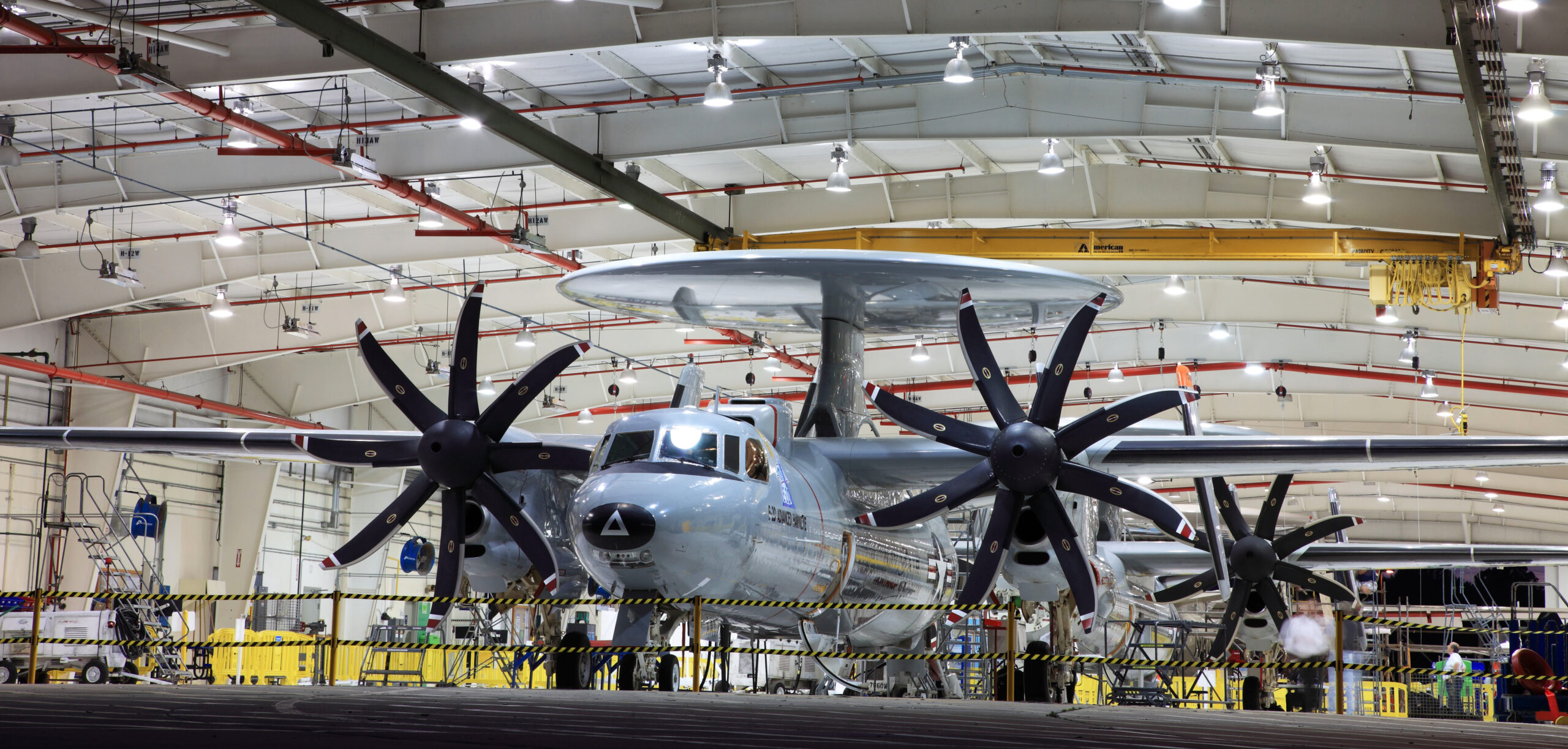
“We’re working through the U.S. government and administration controls, if you will, of what will be the trade space there for future E-2Ds” for those two countries, said Zilch.
And of course, the plant is also modifying 45 Advanced Hawkeyes for the U.S. Navy so they have aerial refueling capabilities. There are still two dozen E-2Ds needing those modifications. Moving forward, all new E-2Ds will have an aerial refueling probe. So far, 10 have been produced.
To assure the Navy maintains the ability to meet its goal of having 22 fully mission-capable Advanced Hawkeyes available at any given time while preparing for future needs requires a delicate balance between operations, maintenance, and modification.
That includes changes like adding the aerial refueling modification. Another update, which the Navy calls the Delta System/Software Configuration Build (DSSC) 3.1 modification, introduces major enhancements to the E-2D’s Joint Tactical Radio System (JTRS) and Link 16 data link so that it can meet DoD-mandated cybersecurity standards in 2021.

There are three other planned DSSC modifications, all requiring E-2Ds to be pulled off the line to be updated, which can, in some ways, be even more challenging than the initial build given the amount of equipment packed into the airplane’s tight confines.
According to Northrop Grumman, they are:
- DSSC 4, designed to deliver “higher performance in the contested environment through improved network connectivity.”
- DSSC 5, designed to deliver “improved sensor and data management through upgrades in security and battle management tools.”
- DSSC 6, designed to deliver “an Open Architecture, Theater Combat ID and Improved Landing Performance. DSSC 6 funding is partial, with expectations for delivery in Fiscal Year 2028.”
It’s all aimed at creating what Northrop Grumman calls “6th-generation command and control” capabilities, a broad initiative that includes multiple upgrade elements for the E-2D to allow integration with future 6th-generation combat aircraft and other systems. Among those are updates will be adopting an open systems architecture that will allow for rapid upgrades and iterative software integration, as well as ‘Theatre Combat ID,’ which helps deliver highly actionable data to the strike group.
To minimize downtown, Northrop Grumman and the Navy plan out maintenance work to coincide with those upgrades.
“So in order to maintain 22 fully mission capable aircraft, while at the same time having a fleet going through modifications to include aerial refueling, to include during the DSSC 3.1 mod, we have to take an aircraft out of the fleet, put it into a mod facility, and now that aircraft is no longer available for the fleet to fly,” Carrillo said. “So there’s a delicate balance that has to happen and close integration with moving aircraft, from the fleet into the mod facility and back out so that we have the inventory in order to make this required 22 fully mission capable [available E-2Ds].”
Keeping Them Relevant
In immediate response to Pelosi’s Taiwan visit, China’s People’s Liberation Army sent 16 Russian-made Su-30 Flanker fighter jets along with 6 J-11s, a Chinese-made Flanker derivative, across the so-called “median line” that bisects the Taiwan Strait on Tuesday. Another 5 J-16s, another Chinese Flanker-derived design, flew into the southwestern corner of the island’s Air Defense Identification Zone, or ADIZ. The next day, there were even more, enough to set a record.
The rapid growth of Chinese air combat capabilities showcased in these Chinese drills is just one real-world reminder of why the U.S. Navy is so invested in keeping the Advanced Hawkeye as advanced as possible.
Given its newer radar, upgraded communications, and ability to fly even longer, the E-2D would have a great ability to track Chinese aircraft, manned or unmanned, as well as missiles, so that they could be targeted should things turn kinetic.
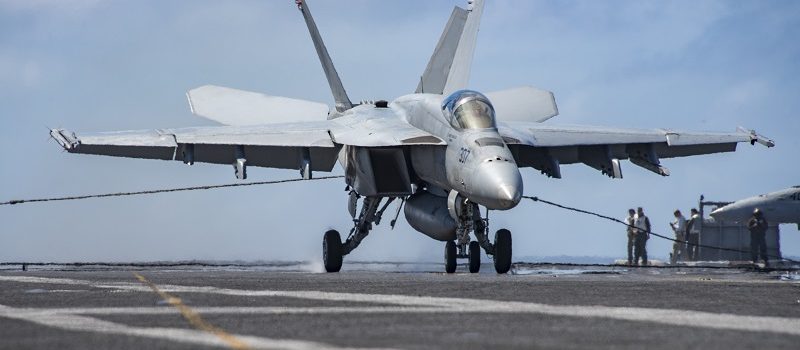
In addition to adding aerial refueling capabilities, the two Advanced Hawkeyes being worked on Tuesday in Building 40 were undergoing several other modifications as well.
They received:
*Dual SATCOM (D/SATCOM), a second radio that can communicate with satellites for secure communication, allowing two people in the E-2D to have secure simultaneous communication.
*Automatic Information System (AIS), an automatic tracking system for commercial ships and is used by vessel traffic services.
“Information provided by AIS equipment, such as unique identification, position, course, and speed, can be displayed on a screen.
*An Embedded National Tactical Receiver (ENT), which provides one integrated tactical information picture by receiving Intelligence Broadcast System (IBS) SATCOM signals through direct to digital RF processing.
*A Link 16/Crypto Modulation/Hybrid Beyond Line of Sight (L16/HBLOS) that enables the exchange of tactical pictures between ships, aircraft, and other entities supporting the exchange of text, imagery, and voice communications.
*Navigation Warfare (NAVWAR) provides a new GPS antenna to provide continued access to information in a denied or impeded electronic environment.
Longer Legs For The Hawkeye
Among all the improvements currently being made to the E-2D, one of the biggest recent changes was creating the aforementioned ability to receive fuel mid-air by adding a probe device atop the cockpit.
Carrier Airborne Early Warning Squadron 120 (VAW-120), the “Greyhawks,” based at Naval Station Norfolk in Virginia, took delivery of the first non-developmental E-2Ds with that system on Sept. 9, 2019.

Advanced Hawkeyes now in the fleet with the DSCC 3.1 modifications that have “aerial refueling, as well as some state-of-the-art tracking improvements, and some classified upgrades” have “given us almost double time-on-station for combat persistence,” said Zilch.
Extending the ability of the E-2Ds to fly about nine hours “gives our operational commanders a lot more presence,” said Carrillo. “From the capability standpoint, to have that endurance on station is huge, right? It just gives us more freedom of maneuver, gives us more capability forward, allows us to track for longer and further out from the ship.”
Adding the capability is one thing. But for a pilot, being able to fly the aircraft behind an aerial refueling tanker, then maneuver it close enough so that the receptacle can link up with the tanker’s drogue takes a great deal of practice to learn.
That training starts on simulators and, later, at the Fleet Replacement Squadron (FRS) in Norfolk, Virginia, actually performing those maneuvers in the air.
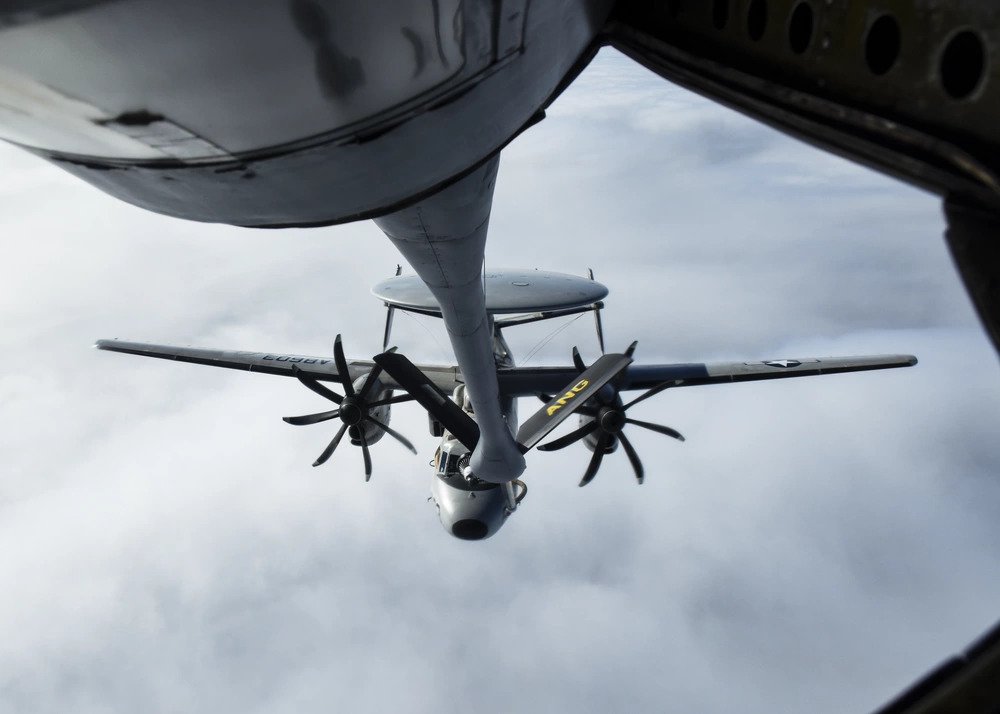
“It adds a few more training flights,” said Carrillo. “But it’s not usually adding time to the training pipeline for our pilots. And they continue once they step into the fleet, they continue to maintain currency.”
But the Navy is also looking to see how to improve the process in the future.
“One of the things we look at with 6th-generation command and control, is how to make that a little bit easier,” said Carrillo. “How do we get behind the tanker more efficiently?”
The Navy is also looking at adding other modifications because it was already challenging enough to fly for four to five hours, then land on an aircraft carrier deck in the dark. Adding additional time on stations raises concerns about crew fatigue.
One of them is improved landing mode, or ILM, a semi-autonomous system to make it easier to land on carriers.

With the added time in the air, “there is a need for improved landing mode,” said Carrillo. “It’s a full contact sport flying that aircraft.”
The ILM concept is similar to another system called Magic Carpet that helps reduce the workload on pilots landing on an aircraft carrier by suggesting appropriate course changes.
Enter HECTR
The Navy and Northrop Grumman are not just working toward ILM to assist pilots. In 2020, Naval Air Systems Command at Patuxent River, Md, awarded Northrop Grumman a $34 million contract for the requirements phase of the engineering, manufacturing, and development of the E-2D Hawkeye Cockpit Technical Refresh (HECTR).
“HECTR is a critical redesign of hardware and software components of the current E-2D Integration Navigation, Controls and Displays System (INCDS) as well as an integration of the cockpit solution into the weapon system,” according to the Navy. “HECTR will use an E-2D Mission Computer Alternative, currently under development…as part of its design. The cockpit redesign will allow the platform to achieve Communication Navigation Surveillance/Air Traffic Management Required Navigation Performance Area Navigation capability.”
“For decades, we have improved the weapon system of the Advanced Hawkeye, but the cockpit has remained largely unchanged,” said Capt. Michael France, Commodore, Airborne Command & Control and Logistics Wing, at the time. “HECTR solves some of our obsolescence issues and brings new navigation and communication capability.”
That includes dealing with pilot fatigue.
“With the [aerial refueling] variant of the E-2D as our new baseline, HECTR makes it safer for our crews who must land on the aircraft carrier after many hours of being on station. HECTR is an essential upgrade that brings the E-2D Hawkeye Cockpit into the 21st Century.”

One problem is that the Advanced Hawkeye’s current INCDS cockpit includes “many of the platform’s top readiness degraders as well as obsolete components,” the Navy said.
Another problem is that the current cockpit architecture will not support the E-2D mission in the so-called 6th-generation command and control system, or Delta System Software Configuration (DSSC) 6 timeframe.
That’s why the Navy in Fiscal Year 2020 began to pursue a cockpit redesign, securing the ability to “reallocate Multi-Year Procurement II (MYPII) savings to the critical cockpit upgrade through the Program Objective Memorandum (POM) cycle.”
The HECTR program goals “will substantially change the pilot and co-pilot experience in the cockpit” as aircrews face greater fatigue from extended flying times, the Navy said.
“HECTR will bring increased safety, decreased pilot workload and increased sustainability to the world’s only carrier-based airborne command & control platform,” said France. “It is a welcome addition to the Advanced Hawkeye and one that will improve our combat readiness and flexibility.”
HUD-less Hawkeye
Once the C-2 Greyhound, the E-2’s close cargo and personnel-hauling cousin, is fully replaced by the CMV-22 Osprey, the E-2D will be the last fixed-wing carrier-based aircraft that lands on the aircraft carrier without a Head-Up Display (HUD).
“Landing can be a difficult task for pilots due to nearly imperceptible wing dips that occur as a result of the lack of a readily available horizon reference and the slow ‘inside-outside’ scan pattern required by the legacy cockpit design,” the Navy said.
HECTR “will integrate a HUD capability to reduce the E-2D pilot workload as well as improve situational awareness and correct current INCDS Human Machine Interface (HMI) deficiencies. The HUD will increase safety and decrease pilot workload for generations of Hawkeye pilots by providing horizon reference and increased visual scan speed for carrier landings, which will be especially beneficial at night and during adverse weather conditions.” This will be done via a helmet-mounted display that will superimpose HUD symbology in front of the pilot’s eye.

HECTR will also replace the existing Avionics Flight Management Computer software with an open, modular, application-based software architecture.
“This architecture redesign will enable the program to sustain mission readiness and execution in DSSC-6 and beyond,” the Navy said. “The program design will also include exportable variants for potential foreign military sales partners.”
The upgrade was scheduled to be fielded with DSSC-6, which Northrop Grumman now says is scheduled for some time in Fiscal Year 2028.
Zilch said she is “excited” about the 6th-generation command and control capabilities of the future.
“That’s going to be key for laying out what the [concept of operations] are for distributed maritime operations. How do you have that open architecture that gives you that app? It’s that app perspective, right? How do you put in AI? How do you put in machine learning? What are the things that you can do going forward to continue this long legacy of capability?”
The “signal from the Navy is very strong,” she said. The capability upgrades will continue. And having that open architecture allows that to be faster, which is what DoD is looking for – how do we get that capability out faster? So I think that gives us a really good strong tenant to do that. And then that allows us to take that capability and port it to whatever will come next.”
Working With Drones
In March of 2021, the Navy announced plans to modify the Advanced Hawkeye’s mission computer so it can also serve as a drone controller, as part of a manned-unmanned teaming experiment. That would allow off-ship command-and-control of the future MQ-25 Stingray, and potentially future drones, too. It’s part of the Navy’s larger effort to build out its drone fleet.
When asked Tuesday by The War Zone about how the Advanced Hawkeye will work with the Stingray, Carrillo said “right now, we are figuring that out.”
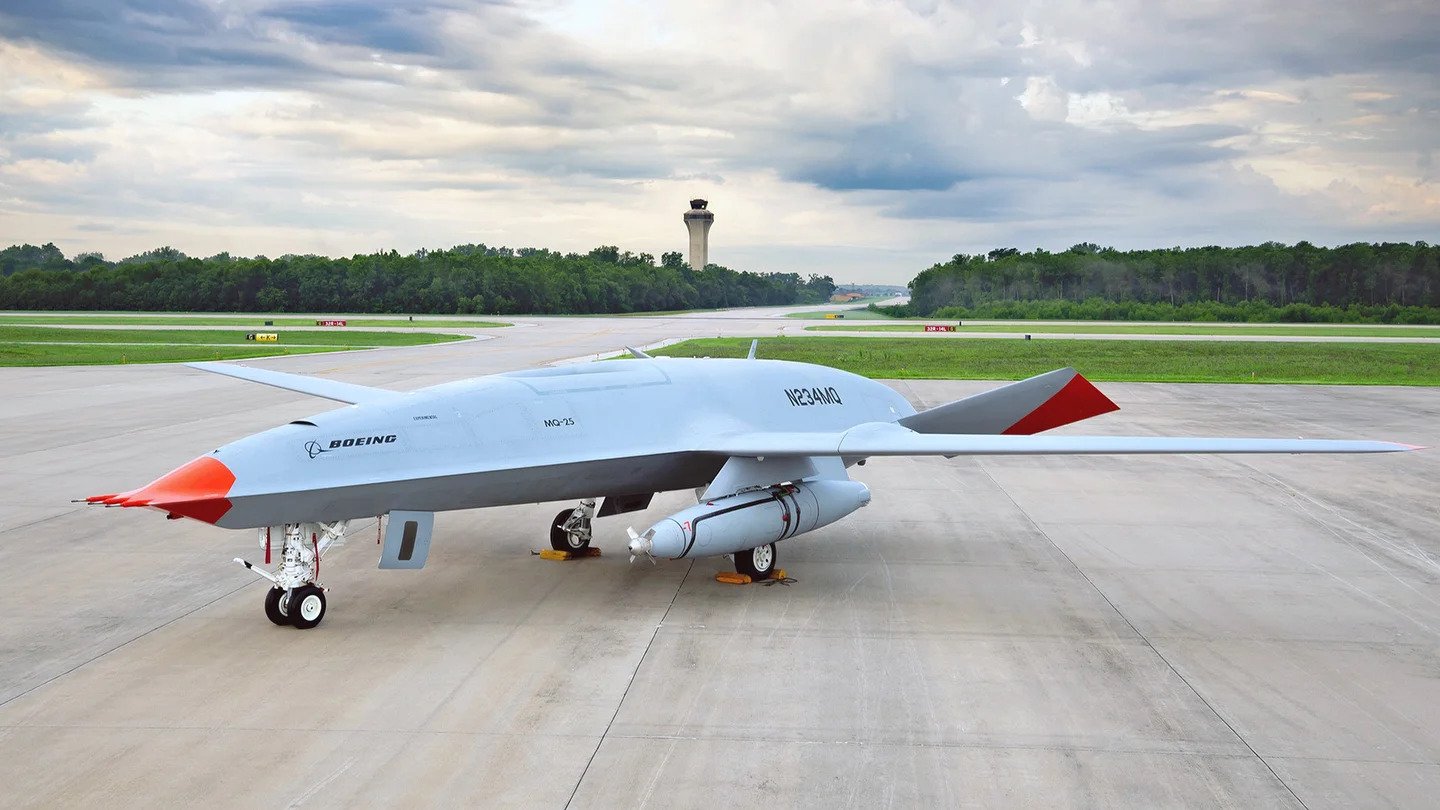
The MQ-25 and other unmanned aircraft of the future are “a critical part of the sixth-generation command and control, as we look at the capabilities and the ability to put systems on the aircraft rapidly to address those opportunities for that capability,” he said. “So we’re still working through that.”
In May, Northrop Grumman, together with Boeing, which makes the MQ-25, conducted a demonstration to “show that the E-2D has command and control utilizing Link 16 with the MQ-25,” said Zilch. “So we can make sure that that can still perform its mission, whatever the comms may be. So we’ve been able to show in multiple simulated demonstrations that we have that command and control ability to message to the MQ-25 and control that.”
The E-2D will also take part in additional demonstrations of distributed maritime operations and joint, all-domain command and control constructs that the U.S. military is trying to build.
The company is “definitely looking at manned-unmanned teaming, crewed and uncrewed teaming, and how that works,” said Scott Villiard, a company spokesman. “And some of those demonstrations are actually intra-Northrop Grumman platforms as well.”
Villiard declined to offer specifics.

Northrop Grumman was also hesitant to offer many details when we asked about the role Advanced Hawkeyes will play with other uncrewed systems deployed to carriers in the future, particularly whether the E-2D will have command and control over them once airborne.
“I don’t want to get too much into that because some of that is…highly classified,” Carrillo said. “But it would be reasonable to think that it’s gonna be a manned-unmanned teaming going forward And the E-2D is a critical part of the command and control part of the battlespace. So it’s reasonable to think that they’re going to be tied together.”
As for whether the E-2D might work with the Protector drone in the future, Carrillo said while it might be a future capability to consider, there are no plans to fund it at this point.
Creature Comforts
Efforts have been underway to make the Advanced Hawkeyes more comfortable for the three crew members who have to work in tight spaces tracking objects and the two pilots who have to fly for hours, and also help in the early warning mission, and then land on aircraft carriers, often in the dark. Aerial refueling extends the E-2’s endurance but also asks for more of its crews, too.
“You know, it’s not an airliner, right?” said Carrillo. “We’re not gonna pretend to say that it’s an airliner. It’s not a Lear jet, right? It’s a combat aircraft that flies on and off an aircraft carrier day or night. So there’s a lot of things that are just generally uncomfortable about the aircraft.”

But there has been a constant effort “to make sure that the systems we have, the seats we have, are comfortable for long periods. It’s evolving. We are continually growing and learning, building and making improvements.”
Northrop Grumman, however, will add even more creature comforts, if asked.
Unlike the U.S. Navy, Japan has required that its E-2Ds have a toilet and microwave. It is unclear why the U.S. Navy hasn’t asked for those amenities or if it will in the future.
Top Gun Star
Neither Carrillo nor anyone else at Northrop Grumman wanted to talk about whether the E-2D could track stealthy objects at long distances or how it works with surface search tracking radar systems and passive sensor capabilities. But they were able to talk about the Advanced Hawkeye’s cameo appearance in Top Gun: Maverick, the sequel to the original Top Gun 1986 Tom Cruise cult sensation.
We asked if Northrop Grumman cooperated with Paramount Studios or whether the studio asked the company about it.
“No, that was Navy driven,” said Zilch. “We had Admiral Whitesell here for a tour right after the premiere. And he was very involved with that. But we were not involved in that. He enjoyed the movie.”
The Navy, Boeing, and Lockheed Martin were extensively involved in the production of Top Gun: Maverick.
Uncertain Future
The last Advanced Hawkeye is set to be completed in 2027, but Northrop Grumman was reluctant to offer too many specifics about what comes next.
“It would be silly to think that the E-2D is going to be the Navy’s last command and control platform,” said Carrillo. “We are in the process. It’s still very early into figuring out what’s next. As we look at E-2D going into the 2040s and the capabilities moving forward, we need to be working on what’s next. And there’s interest from the Navy. There’s interest from industry. And so the short answer is yes, we are looking out. We are not going to talk about what that capability is or what we’re thinking. But the Navy’s Command and Control Program Office is starting to work through that. And then obviously, we’re going to leverage 60 years of experience.”
But one thing is certain.
There is plenty of room for continued growth, something the company obviously thought of when purchasing and later upgrading the St. Augustine facility.
About a decade ago, Northrop Grumman invested about $120 million into the St. Augustine line. That includes the massive, 364,000-square-foot Building 100, where upwards of a dozen Advanced Hawkeyes can be built in a year, if that capacity were needed. Considering the state of world affairs, that is a possibility.
While only about seven or eight a year are being built now, the facility’s modular layout and key electrical and HVAC components under the floor mean that it can also accommodate the construction of a wide range of aircraft types and sizes.
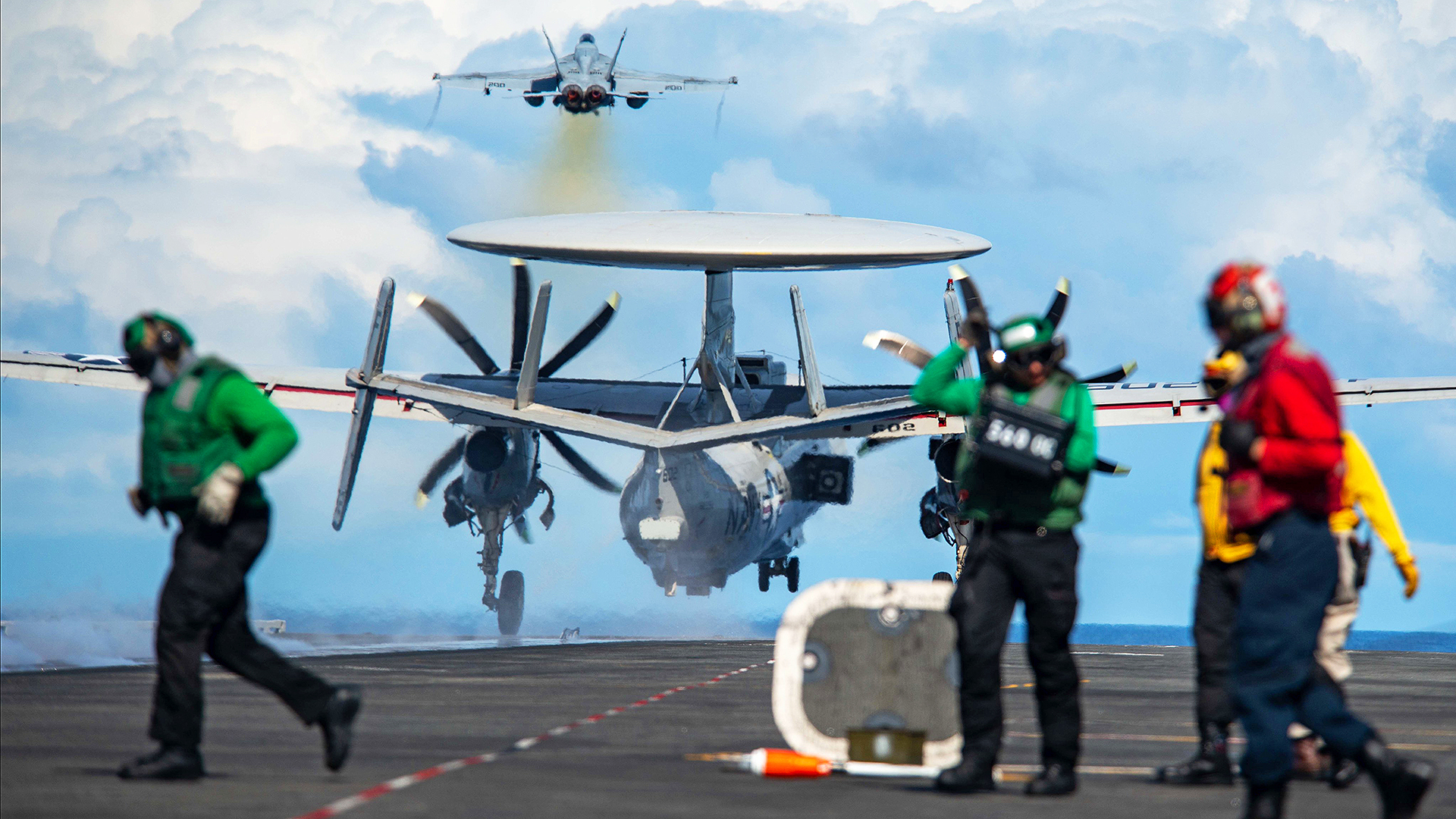
And while the process for building E-2Ds for the U.S. Navy is too far along to make robot-augmented construction cost-effective, Northrop Grumman is using an ElectroImpact robot it dubbed “MOBI” (though another name choice was “E2D2”) to help drill and inspect holes in the wings sections for the Japanese models.
That’s because the Japanese versions allow Northrop Grumman to use MOBI without reconfiguring the entire production process.
But moving forward, having that technology will come in very handy on systems that are designed with robot-augmented construction in mind.
So, while the Advanced Hawkeye’s future may not be indefinite, the St. Augustine plant could become the birthplace of new designs.
Still, the Hawkeye has a lot of years ahead of it, and after six decades, the Navy still hasn’t found a better solution for all that it offers its fleet. This is an incredible testament to the design and all those who worked to keep the venerable platform relevant over all these years and into the future.
Contact the author: howard@thewarzone.com
